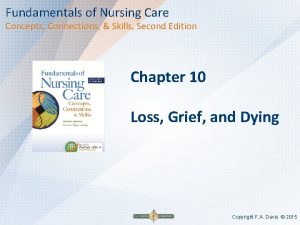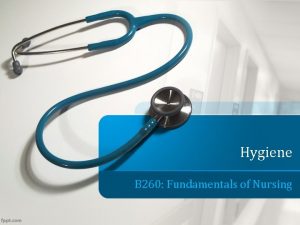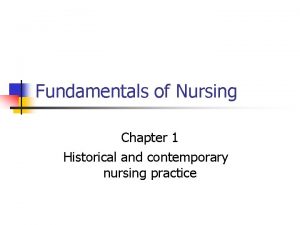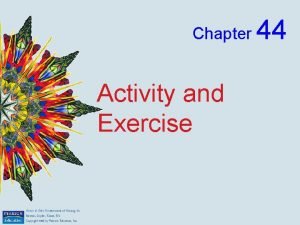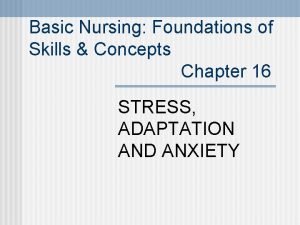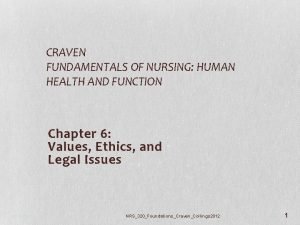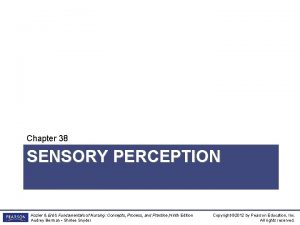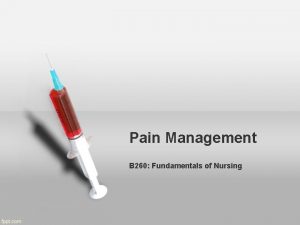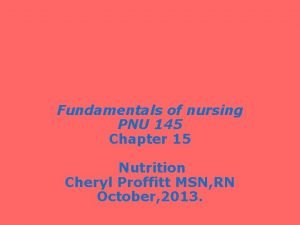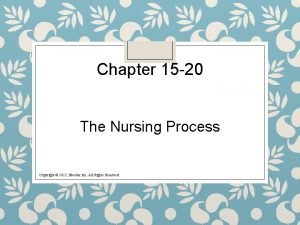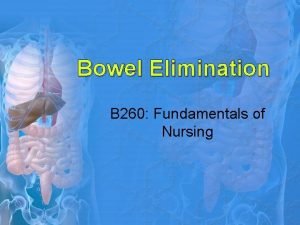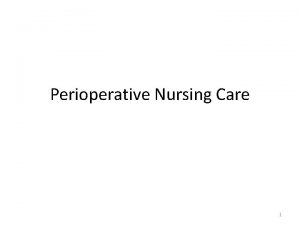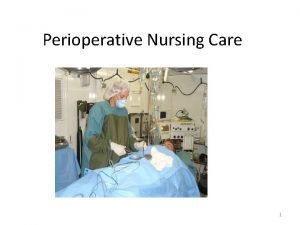Fundamentals of Nursing Care Concepts Connections Skills Second


























- Slides: 26

Fundamentals of Nursing Care Concepts, Connections, & Skills, Second Edition Chapter 16 Moving and Positioning Patients Copyright F. A. Davis © 2015

Fundamentals of Nursing Care Concepts, Connections, & Skills, Second Edition Terminology Related to Movement § Contractures § Shortening and tightening of muscles due to disuse § Dorsiflexion § Bending of the foot in an upward direction § Plantar flexion § Bending of the foot in a downward direction Copyright F. A. Davis © 2015

Fundamentals of Nursing Care Concepts, Connections, & Skills, Second Edition Terminology Related to Positioning Patients § Log roll § Patient is turned in the same way a log would be rolled (as one unit) § Trochanter roll § Tightly rolled sheet or blanket placed against the lateral side of the thigh to prevent outward motion of the hip and leg Copyright F. A. Davis © 2015

Fundamentals of Nursing Care Concepts, Connections, & Skills, Second Edition Hazards of Immobility § § Blood clots Pneumonia Bone demineralization Kidney stones Copyright F. A. Davis © 2015

Fundamentals of Nursing Care Concepts, Connections, & Skills, Second Edition Hazards of Immobility (cont. ) § § Constipation Pressure ulcers Urinary retention Depression Copyright F. A. Davis © 2015

Fundamentals of Nursing Care Concepts, Connections, & Skills, Second Edition Body Systems Affected by Immobility § § § § Musculoskeletal Cardiovascular Respiratory Gastrointestinal Urinary Integumentary Neurological Psychological effects Copyright F. A. Davis © 2015

Fundamentals of Nursing Care Concepts, Connections, & Skills, Second Edition Preventing Musculoskeletal Complications § Maintain proper body alignment § Keep the head, trunk, and hips in a straight line § Prevent the legs from rotating in the hip socket medially or laterally § Maintain arms in correct alignment with the shoulders Copyright F. A. Davis © 2015

Fundamentals of Nursing Care Concepts, Connections, & Skills, Second Edition Nursing Actions to Prevent Contractures and Osteoporosis § Perform ROM exercises every 8 hours § Support the weight of the extremity at the joints § Apply any supportive or therapeutic devices for maintaining body alignment § Assist with ambulation as soon as orders permit Copyright F. A. Davis © 2015

Fundamentals of Nursing Care Concepts, Connections, & Skills, Second Edition Effects of Immobility on the Cardiovascular System § Venous thromboembolism (VTE) § Orthostatic hypotension § Syncope Copyright F. A. Davis © 2015

Fundamentals of Nursing Care Concepts, Connections, & Skills, Second Edition Nursing Measures to Prevent Cardiovascular Complications § Encourage the movement of extremities § Apply ordered devices to prevent pooling of blood in the legs § Gradually move the patient from lying to sitting or to a standing position § Change the patient’s position frequently § Remain with the patient the first few times getting out of bed and dangling Copyright F. A. Davis © 2015

Fundamentals of Nursing Care Concepts, Connections, & Skills, Second Edition Nursing Measures to Prevent Respiratory Complications § § Turn the patient from side to side every 2 hours Elevate the head of the bed 45 degrees Encourage coughing and deep breathing Encourage use of the incentive spirometer Copyright F. A. Davis © 2015

Fundamentals of Nursing Care Concepts, Connections, & Skills, Second Edition Nursing Measures to Prevent Gastrointestinal Complications § Assist the patient with early ambulation § Reposition the patient every 2 hours; encourage ROM exercises § Place the patient in a sitting position on the bedpan § Inquire about food likes and dislikes and plan balanced meals § Encourage fiber and fluid intake § Administer a laxative or stool softener PRN Copyright F. A. Davis © 2015

Fundamentals of Nursing Care Concepts, Connections, & Skills, Second Edition Nursing Measures to Prevent Urinary Complications § Encourage fluids to prevent concentrated urine § Assist female patients to urinate in a sitting position § Assess the patient’s output Copyright F. A. Davis © 2015

Fundamentals of Nursing Care Concepts, Connections, & Skills, Second Edition Nursing Measures to Prevent Integumentary Complications § Provide adequate nutrition § Reposition the patient every 2 hours § Inspect bony prominences for redness every 2 hours and massage the area around the redness § Use mild soaps for cleansing skin § Provide an appropriate surface for the patient Copyright F. A. Davis © 2015

Fundamentals of Nursing Care Concepts, Connections, & Skills, Second Edition Nursing Measures to Prevent Neurological Complications § Determine the patient’s level of consciousness by asking specific questions relating to person, place, and time § Use a footboard to keep feet in a natural position § Perform neurological checks § Provide clues in the room to the correct date and time Copyright F. A. Davis © 2015

Fundamentals of Nursing Care Concepts, Connections, & Skills, Second Edition § § § § Psychological Effects of Immobility Depression Anxiety Hostility Fear Isolation Restriction of self-image and independence Sensory deprivation Difficulty sleeping Copyright F. A. Davis © 2015

Fundamentals of Nursing Care Concepts, Connections, & Skills, Second Edition Nursing Measures to Prevent Psychological Complications § Minimize sensory deprivation § Involve patient senses when with the patient § Encourage the patient to remain awake during the day and do as much for the self as possible § Allow the patient to express concerns § Encourage visits from family and friends Copyright F. A. Davis © 2015

Fundamentals of Nursing Care Concepts, Connections, & Skills, Second Edition Position of Function § Places the extremities in alignment § Maintains the potential for their use and movement § Helps prevent undue pressure on the nerves § Helps prevent discomfort, pain, and nerve damage § Uses devices including pillows, hand rolls, arm boards, and foot boards Copyright F. A. Davis © 2015

Fundamentals of Nursing Care Concepts, Connections, & Skills, Second Edition Common Patient Positions § Supine: Lying on back, arms at side § Dorsal recumbent : Lying on back, arms at sides, legs apart, knees bent, feet flat § Trendelenburg : Lying on back, arms at side, feet higher than head § Reverse Trendelenburg : Lying on back, arms at side, head higher than feet § Lateral: Lying on back or right side, supported by pillows Copyright F. A. Davis © 2015

Fundamentals of Nursing Care Concepts, Connections, & Skills, Second Edition Common Patient Positions (cont. ) § Left Sims: Left side semi-prone, right leg drawn up to chest, left arm along patient back § Right Sims: Right side semi-prone, left leg drawn to chest, right arm along patient back § Low, semi-, and high Fowler’s: Semi-sitting with various degrees of head elevations § Orthopneic : Sitting upright, leaning slightly forward, arms supported on overbed § Prone: On stomach with head to side § Lithotomy: On back, legs in stirrups Copyright F. A. Davis © 2015

Fundamentals of Nursing Care Concepts, Connections, & Skills, Second Edition ANA Handle With Care® Campaign § Instituted in response to significant number of musculoskeletal disorders reported by nurses § “No lifting” programs; instead, use lift equipment § Sit-to-stand lifts, hydraulic lifts, battery-powered lifts Copyright F. A. Davis © 2015

Fundamentals of Nursing Care Concepts, Connections, & Skills, Second Edition Devices Used to Move Patients § § § Transfer belts Nylon friction reducing devices Slide boards Partial or full weight-bearing assist devices Overhead ceiling lift devices Copyright F. A. Davis © 2015

Fundamentals of Nursing Care Concepts, Connections, & Skills, Second Edition Support Surfaces and Specialty Beds § Mattress overlays § Specialized mattresses § Specialty beds § § Air-fluidized bed Low air-loss bed Combination air-fluidized and low air-loss bed Continuous lateral-rotation bed Copyright F. A. Davis © 2015

Fundamentals of Nursing Care Concepts, Connections, & Skills, Second Edition Information in the Connection Features § § § § Clinical Connection Knowledge Anatomy and Physiology Patient Teaching Real World Supervision/Delegation Post Conference Copyright F. A. Davis © 2015

Fundamentals of Nursing Care Concepts, Connections, & Skills, Second Edition Information in the Safety Features § Why are the particular safety features so important that they are highlighted as safety issues? § What could happen if those safety guidelines are not followed? Copyright F. A. Davis © 2015

Fundamentals of Nursing Care Concepts, Connections, & Skills, Second Edition Information in the Skills Procedures § Review the steps of each of the skills procedures. § Make sure you understand why the steps are important. § What could happen if each of the steps are not followed or are followed out of order? Copyright F. A. Davis © 2015
 Fundamentals of nursing care concepts connections & skills
Fundamentals of nursing care concepts connections & skills Biology
Biology Biology concepts and connections 4th edition
Biology concepts and connections 4th edition Obsessive compulsive disorder nursing care
Obsessive compulsive disorder nursing care Post operative nursing care plan for cataract
Post operative nursing care plan for cataract Working connections
Working connections Primary secondary tertiary health care
Primary secondary tertiary health care 27 miles per gallon into kilometers per liter
27 miles per gallon into kilometers per liter Hygiene fundamentals of nursing
Hygiene fundamentals of nursing Fundamentals chapter 1
Fundamentals chapter 1 Activity and exercise fundamentals of nursing
Activity and exercise fundamentals of nursing Stress and adaptation fundamentals of nursing
Stress and adaptation fundamentals of nursing Admission hospital
Admission hospital Fundamentals of nursing craven
Fundamentals of nursing craven Sensory functioning fundamentals of nursing
Sensory functioning fundamentals of nursing Nursing goals for pain
Nursing goals for pain Purpose of malnutrition
Purpose of malnutrition Fundamentals of nursing chapter 17 vital signs
Fundamentals of nursing chapter 17 vital signs Fundamentals of nursing chapter 15 critical thinking
Fundamentals of nursing chapter 15 critical thinking Nutrition fundamentals of nursing
Nutrition fundamentals of nursing Bowel elimination fundamentals of nursing
Bowel elimination fundamentals of nursing Vitals include
Vitals include Critical thinking model nursing
Critical thinking model nursing Different lying positions nursing
Different lying positions nursing Bedpan placement
Bedpan placement The fundamentals of care framework
The fundamentals of care framework Reclaiming and redefining the fundamentals of care
Reclaiming and redefining the fundamentals of care
